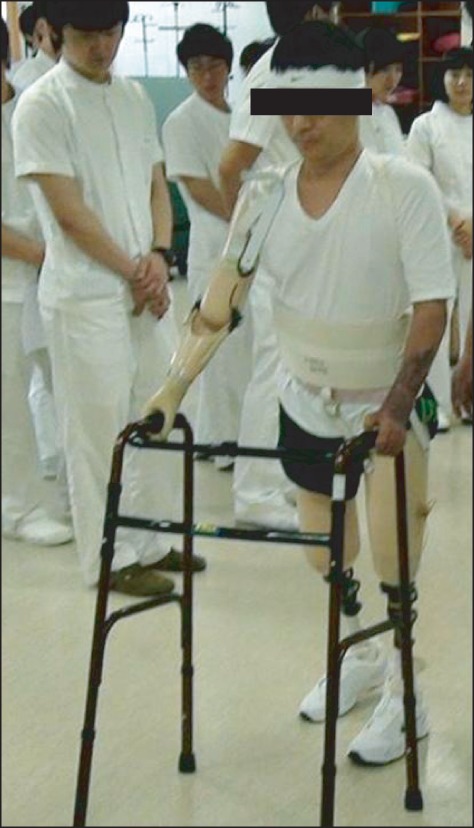Ann Rehabil Med.
2014 Feb;38(1):116-121. 10.5535/arm.2014.38.1.116.
Stepwise Rehabilitation of the Triple Amputee Combined With Dysfunction of the Sound Limb
- Affiliations
-
- 1Department of Rehabilitation Medicine and Research Institute of Rehabilitation Medicine, Yonsei University College of Medicine, Seoul, Korea. danggn82@hanmail.net
- KMID: 2266549
- DOI: http://doi.org/10.5535/arm.2014.38.1.116
Abstract
- To find a multiple amputee more severe than a triple amputee is not easy. This is a report of a 36-year-old patient with right knee disarticulation, left trans-femoral amputation and right elbow disarticulation due to peripheral ischemic necrosis, when he was applied vasopressor in septic shock condition. His left hand was also 2nd, 3rd, 4th, and 5th distal interphalangeal joint disarticulation status, and it was more difficult for him to do rehabilitation program, such as donning and doffing the prostheses. For more efficient rehabilitation training program, we first focused on upper extremities function, since we believed that he might need a walking aid for gait training later. After 13 weeks of rehabilitation program, he has become sit to stand and walk short distance independently with an anterior walker. Although he still needs some assistance with activities of daily living, his Functional Independence Measure score improved from 48 to 90 during the course of 13 weeks.
MeSH Terms
Figure
Reference
-
1. Kitowski VJ, Leavitt LA. Rehabilitation of a quadruple amputee. South Med J. 1968; 61:912–914. PMID: 5676572.
Article2. Shin JC, Park CI, Kim YC, Jang SH, Bang IK, Shin JS. Rehabilitation of a triple amputee including a hip disarticulation. Prosthet Orthot Int. 1998; 22:251–253. PMID: 9881614.
Article3. Shaw M, Kaplow M, Mitchell N, Stillwell D. Traumatic triple amputation: psycho-social problems in rehabilitation. Arch Phys Med Rehabil. 1977; 58:460–462. PMID: 907454.4. Davidson JH, Jones LE, Cornet J, Cittarelli T. Management of the multiple limb amputee. Disabil Rehabil. 2002; 24:688–699. PMID: 12296984.
Article5. Park JM, Kim YJ, Kim IS, Lee YT, Kim SH, Kim YH, et al. Rehabilitation for ambulation of triple amputee: a case report. J Korean Acad Rehabil Med. 2007; 31:123–126.6. Huang CT, Jackson JR, Moore NB, Fine PR, Kuhlemeier KV, Traugh GH, et al. Amputation: energy cost of ambulation. Arch Phys Med Rehabil. 1979; 60:18–24. PMID: 420566.
- Full Text Links
- Actions
-
Cited
- CITED
-
- Close
- Share
- Similar articles
-
- Rehabilitation for Ambulation of Triple Amputee: A case report
- Assessment of Quality of Life in Lower Limb Amputees Using Short-Form 36
- Gait Characteristics of Transfemoral Amputees in Long Term Users of Poly Centric Knee
- A Case of Verrucous Hyperplasia in An Amputee
- Rehabilitation of the Bilateral Upper Extremity Amputees




